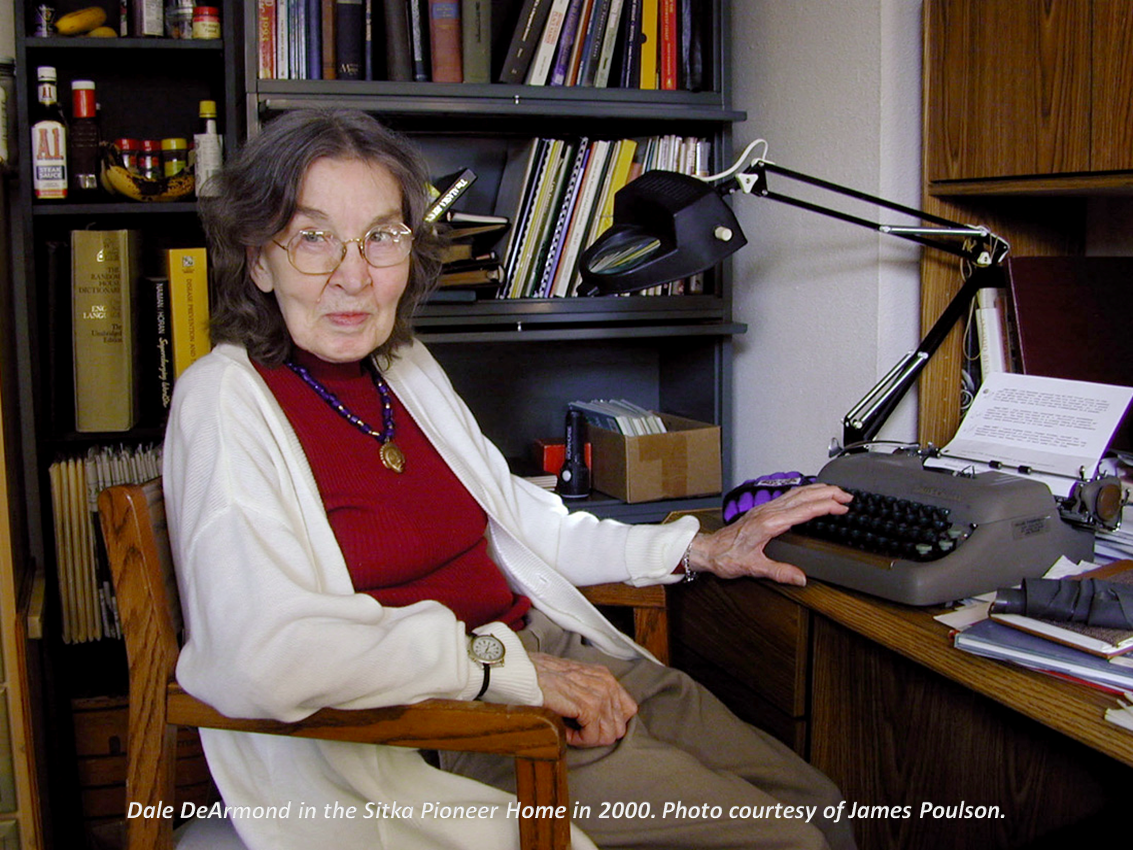
This interview first appeared in the September 2000 issue of Alaska Magazine. It is reprinted here with permission of the author.
Photo of DeArmond courtesy of James Poulson.
by Ellen Bielawski
When Dale DeArmond studied art in the late 1950s, she did it by mail. The correspondence school that administered her program, the Famous Artist's Course, was based in Rhode Island. When one of her assignments required that she create a pastoral scene, Dale painted an imaginary farm with the mountains near her Juneau home for background. This critique came back: "The mountains are way out of proportion!" DeArmond chuckles in her apartment at the Sitka Pioneers' Home.
"The mountains probably did seem out of proportion to someone in Rhode Island."
Dale went on to complete that correspondence course, but her enthusiasm for art had developed far earlier. When her family moved from her birthplace of Bismarck, N.D., to Tacoma, Wash., they traveled by train. DeArmond remembers only two details vividly: the trip was very long for a 5-year-old, and her crayons fell on a radiator and melted.
She came to Sitka in 1935, at the invitation of her soon-to-be-husband, Robert DeArmond. The couple had met in high school in Tacoma, while dissecting a frog in biology lab. After graduation, he moved north and they lost touch. In 1931, however, Robert rowed a dory from Sitka to Tacoma looking for work. His long trip in a small boat made the local newspapers; Dale read the story and contacted Robert. One thing led to another, and in 1935 the former lab partners entered into a marriage that has lasted a lifetime, during which they've lived in Sitka, Pelican, Ketchikan, and Juneau.
Dale remembers liking Sitka early – a town of only 1,200 people when she arrived – and feeling it was a pleasant change from the more urban environment she was used to. Still, she says Sitka was and is the "most civilized town" in southeastern Alaska.
Following their move to Pelican, the couple lived in a tent with two very young children. "There weren't any houses to live in," Dale says. "It was a big tent, you know."
Robert gave her the Famous Artist's Course as a Christmas present. It served as a sort of creative springboard for Dale, who went on to work in pastels and experimented in hammering copper. Then, in the early 1960s, she learned woodcutting from Danny Pierce, who taught a printmaking and woodcut class at what is now the University of Alaska Juneau campus.
Dale became enthralled with wood engravings. She liked the feel and smell of wood, and the level of detail the craft demands. She came to prefer this to woodcutting. Engraving uses small pieces of hardwood, in contrast to the large "canvasses" of softwood, such as yellow cedar, that woodcuts require. The tools used to engrave hardwood are also smaller and more precise than the knives and gouges used for woodcuts. Wood engraving was once a more common, and even prosaic, occupation, but it was elevated into an art form after photographs replaced engravings as the common means of illustrating catalogs, newspapers, books and even magazines.
This is far from the first time that Dale's artwork has graced the pages of this magazine. Robert DeArmond and Bob Henning actually purchased Alaska (Magazine) in 1958, and Henning later sold Dale's signed, numbered prints through the magazine. (Some were also bound into the publications as bonuses for Alaska's readers).
Dale says that she always found time for her art "in between" chores and mothering. She never had a formal studio. "The kitchen table worked well, as did the bench in the basement that doubled as a laundry table," she says.
DeArmond's engravings frequently featured Raven, who plays the role of trickster in many Alaska Native tales and legends. She is fond of these stories and intrigued by Raven's character. Dale explains that some of her knowledge of the subject comes from Robert, who is an adopted member of the Raven clan.
Perhaps DeArmond's favorite work, however, has been illustrating, in particular the many drawings she has created for children's magazines. But her "adult" creations have brought her the widest acclaim. She has sold her art to customers as far from Alaska as South Africa, and done lithograph work in Paris and England.
How does she feel about being famous? "Well," she says, "it's easy to be famous in Alaska!" Today Dale speaks to me from a rocking chair. She wears a dark checked flannel shirt and glasses, is a bit hard of hearing, but remains as alert as the raven that squawks outside on this rare and glorious, sunny Sitka day. She gave up wood engraving about a year ago, and says she doesn't miss it much. "Enough is enough."
Instead, the artist is experimenting with a new medium; she's writing a historical novel. The story is set in potato-famine Ireland, at the time when her then 14-year-old great-grandmother left the country. DeArmond is calling upon memories of her great-grandmother from childhood days in North Dakota. She tells me that the old woman smoked a clay pipe and let Dale light it.
DeArmond is writing the novel in longhand in a blue-lined student notebook. She's enthusiastic about the project and not about to set any limits for it yet.
"I'll write until I run out of plot," she says.